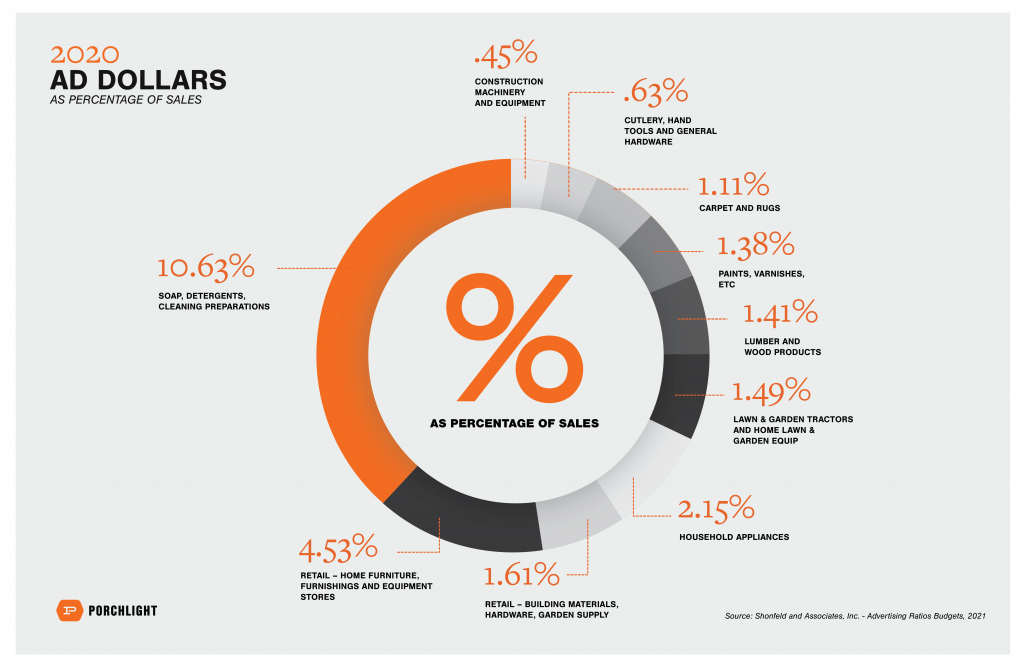
We’re talking about money again. The more clients we speak to, the more we understand the increasing demands being placed on tight budgets. It’s a real challenge to develop a budget that is comprehensive and delivers ROI. And agencies can add to the complexity because we all take a slightly different approach to pricing. While we can’t fix agency pricing across the board, we can offer our own straightforward advice for planning and allocating your marketing budget. Like most things, it’s a balancing act. On one hand, you have media. On the other hand, there’s creative. And neither is free.
Step 1: Using the Sales-to-Advertising Ratio to Define Your Budget
Your sales-to-advertising spend ratio is the percentage of sales you spend on advertising. Generally speaking, that amount is comprehensive, including media spend, agency costs, salaries and administrative costs. In home improvement retail, the sales-to-ad ratio is typically between 1% and 10% depending on the product.

This wide range of sales-to-advertising ratios mostly reflects the variety of industries that fall under home improvement. The individual ratios are influenced by factors like competition, brand maturity, new product introductions, retailer mandates and internal goals.
Compare products like building materials, which have low advertising spend, to consumer packaged goods, which are the bread and butter of advertising. Building materials can afford to spend less because the market is less competitive and less consumer-driven, and product life spans are longer. On the other hand, consumer packaged goods like cleaning and paper products have short product life cycles and face high competition between brands.
No matter the category, new product launches call for higher-than-average advertising spend. Most experts advise budgeting 20% of sales for advertising and marketing new products because it takes more to build a brand than to maintain it.
If your industry is stable, your brand awareness is growing steadily and your retailer feedback is good, you will most likely have a consistent budget year over year. But if you are facing new goals or challenges – such as a new competitor entering the market or a retail merchant mandate to include 50% PCR in your product packaging – your ratio should be on the higher end of the spectrum.
Step 2: How to Determine How Much of Your Budget to Spend on Agency Fees
When we talk to clients about budgets, we consider two costs: media and creative. If you are a fan of the 4 Ps of marketing, you can call these place and promotion. You rent space (i.e., place) and use it to display creative content to promote your message. Different agencies approach these costs in various ways. Some lump them together, marking up media to pay for creative. The problem with this is that it tends to flatline creativity and quality by making the value of the creative contingent on the value of the media. Other agencies simply avoid media, instead trading exclusively in creative. Here, ideas and campaigns come at a premium.
At Porchlight, we treat budgets like a balanced scale, with creative on one side and media on the other. Our goal is to create the right balance to deliver marketing ROI. When we throw too much creative on the scale, we hinder the client’s ability to display it. Equally unbalanced is the overly ambitious media spend that can’t afford anything more than quick, cheap creative to back it up. In addition to balance, we push transparency and quality: “If X is your channel strategy, then Y is what we will charge to supply you with compelling, branded content.” We may be biased in our view that place and promotion deserve equal weight, but impressions only get you so far. The difference between ambivalence and action is meaningful content.
Step 3: Allocating and Prioritizing Your Media Spend
When it comes to allocating your budget, start with your goals. Brand awareness, sales, ratings and reviews are just a handful of goals that will render differing priorities. But once you have a strategy in place, you are ready to weigh your media options. These include traditional and digital media, retail media, merchandising and promotions. Consider the following list of media costs. Each has its own advantages and circumstances that call for more or less spend.
Media
Every dollar you spend to buy space for your brand in public is considered media. This includes traditional media like radio, TV, publications and billboards. It also includes digital media such as social media, search engine marketing, content marketing and anything you spend on your own website. Media often occupies the biggest chunk of a marketing budget because media is seen as the best way to reach the widest audience.
Your media spend will be first on the scale when your company has prioritized audience engagement and brand awareness. It will be last on the scale when you are looking to increase sales online or in retail.
Retail Media
Everything you spend through a retailer is considered retail media. This includes in-store marketing and retailer-controlled media such as the retailer’s ecommerce, search, email and social media channels. Think sponsored content on amazon.com or homedepot.com, sponsored content in Home Depot consumer and pro emails, and in-store promotions and flyers.
If your product is available online or in-store with a retailer, this category of media should be at the top of your list. The ROI is high because you are advertising to pre-qualified shoppers. If they are seeing your content, they are interested.
Merchandising
Merchandising includes everything to support your product in-store, from packaging and POP to associate training. This is a category of media that is often underrated. If your product is for sale in stores, merchandising can make or break sales, especially if you have a product that is not a routine purchase. Merchandising helps shoppers find your product and, once they find it, convinces them that your product is the best.
Merchandising will be high on your list in three circumstances. First, merchandising spend may come out of a product line review or other merchant requirement. It might also become a top priority after a store walk when you notice your product is not presenting well. And merchandising is always top of mind during a new product launch in retail.
Promotions
With the worldwide marketplace at our fingertips 24/7, consumers are becoming increasingly dependent on online ratings and reviews to inform their purchases. Any money you spend to solicit ratings and reviews online is considered promotional. Ratings and reviews can also help SEO by increasing product placement in Google and ecommerce searches, especially when products are mentioned by name.
If you have a new product, a product that you are looking to improve upon or a product whose sales are lagging, increased promotional spend can help add credibility or boost sales.
Step 4: Working with Your Agency Partner to Balance Creative and Media Costs
Once you have your media priorities added to the scale, you can start to add to the creative costs. For each of the buckets listed above, you will need creative to give it meaning. A good agency partner will look at your media list and provide a cost to fulfill all of your expectations. A great creative partner will look at your list and give you options, beginning with costs to deliver as requested and including their advice for adding to it, and what they’d take away.
In an ideal world, we’d all have huge budgets to do with whatever we like. We’d find out pretty quickly what works, and what doesn’t. But that’s never been the case with our clients or ourselves for that matter. Budgets are always tight, and decisions have to be made about what to do, and what not to do. Ultimately, we are in the business of ROI as much as marketing or creative services. And ROI comes from having great creative in the right place, at the right time. It’s the balance that delivers results. If you want to find the right balance for your brand or organization, we can help.